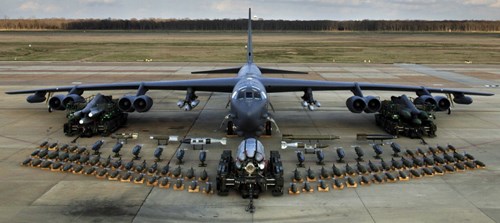“Bombing diplomacy”
In an effort to have the upper hand in the ongoing negotiations in Paris, in December 1972, the US side attempted to use their air force to attack North Vietnam over the Christmas holiday. The Pentagon then kicked off Operation Linebacker II (referred to as “Dien Bien Phu in the air” by Vietnam and “Christmas bombing” by Western countries), using B-52 strategic bombers to massively bomb facilities, mostly in Hanoi, Hai Phong and a number of other cities in the North.
    |
 |
A Boeing B-52 'Stratofortress'. Photo: nationalinterest.org
|
The US operation resorted to carpet bombing, regardless of civilian losses, in an attempt to destroy agencies of the Government, military complexes and units, transport and communication lines, railway stations, sea ports, and more of the Democratic Republic of Vietnam. The US hoped to neutralize the “head” and destroy the food supplies for the resistance war against US imperialists and eventually force the Government of the Democratic Republic of Vietnam to accept the provisions in favor of the US side in the negotiations in Paris.
From high belief in technology…
According to field reporter Neil Sheehan, a squadron of six B-52 aircraft when bombing can destroy everything within the rectangular area of 3.2km x 9km (or up to 12km). The aircraft was also the US major weapon for deterrence missions against the Soviet Union during the Cold War. In case of the third World War, the US would have used B-52 aircraft armed with nuclear bombs to attack the Soviet Union.
During Operation Linebacker II, the US Air Force used 197 B-52 aircraft, equivalent to all the strategic bombers in the Asia-Pacific region and half of the commissioned B-52 aircraft of the US Air Force then. The force balance between the US forces and those of the Democratic Republic of Vietnam was totally unequal and in favor of the US.
Confronting the powerful airborne forces of the US was the fledgling air defense system of Vietnam using weapons supported by friendly socialist countries. The US authorities believed that the S-75 Dvina missiles (NATO reporting name SA-2) would become “blind” and MiG-21 fighters of Vietnam would be neutralized easily by a powerful squadron of B-52 escort fighters. What’s more, the anti-aircraft artillery batteries and machine-guns would be of no use with their limited ranges.
Strongly protected B-52 aircraft called “unbreakable stratofortresses” were expected to take a troll around the airspace of the North of Vietnam and were believed to be prevented only by the weather or technical problems.
…to the shaken Pentagon
During the 12 days and nights, the US Air Force dropped more than 36,000 tons of bombs, more than the total volume of bomb that the force used from 1969 to 1971 on the North of Vietnam. Hanoi alone was attacked with more than 20,000 tons. Thousands of houses, schools, hospitals, dykes and dams, etc. were destroyed.
Contrary to the expectation of the Pentagon’s strategists, however, 34 B-52 aircraft were downed, shaking the US authorities. As reported by US B-52 pilots in those days, they encountered unprecedentedly-fierce resistance of the air defense system of the Democratic Republic of Vietnam, including weapons thought to be unable to reach the altitude that B-52 operated.
The US Strategic Air Command suffered great losses when encountering the willpower of a small country like Vietnam. The anti-war movement broke out much more widely worldwide and the US prestige in the international arena was severely damaged. What added to the failure of Operation Linebacker II was that not a single bomb could hit the headquarters of the resistance war against the US forces then. It meant the US military goal went totally bankrupt.
The 12 days and nights of the “Dien Bien Phu in the air” marked a great victory, proving that weapons and war technology of the biggest war engine of the world couldn’t bend a country’s unyielding willpower in its campaign to gain independence and reunify the nation.
Translated by Huu Duong